Level 8 Music Theory Exam
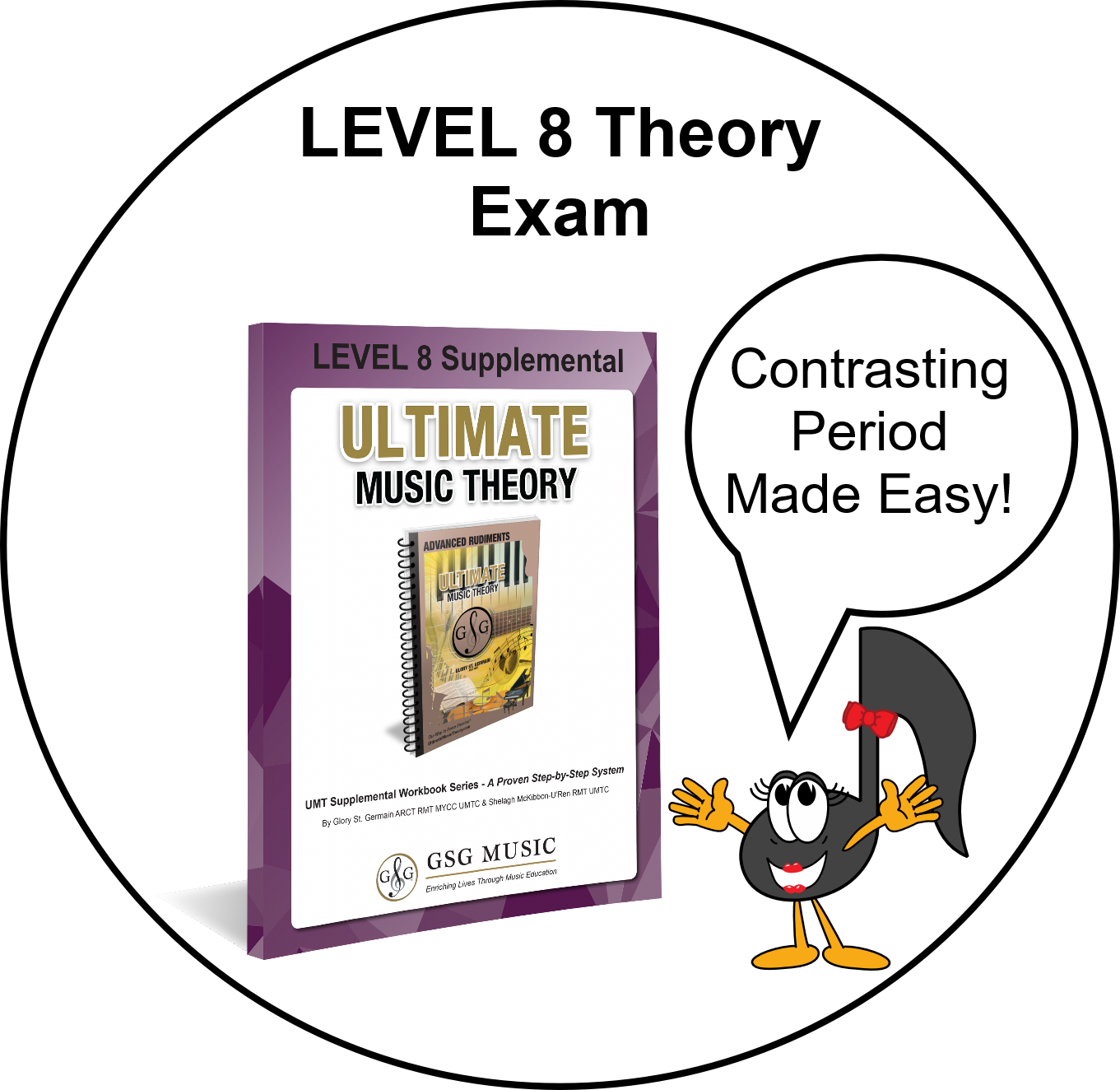
To prepare for the RCM Level 8 Music Theory Exam, students will need to know how to:
- Complete the final 2 measures in a 4-measure "Question Phrase", ending on an unstable scale degree.
- Compose a 4-measure "Answer Phrase" to create a Contrasting Period, ending on a stable scale degree.
- Name the type of Cadence at the end of the Question ("a") Phrase and the Answer ("b") Phrase (Half or Authentic).
Writing a melody does not have to be complicated! Here are 4 Tips to make it easy.
Level 8 Music Theory Exam - Tip #1
When writing a Contrasting Period Melody, it is very important to remember that the melody is to be written in Baroque Style.
The Baroque Period (Baroque Era) was the music from around the 1600s to around the 1750s (ca 1600 - ca 1750). (Think "Bach", not the "Beatles"!)
Music during this Period often featured a single melodic line (single melody) with chordal harmony (harmonized by chords). The most popular chords used to write these simple melodies were the Tonic, Subdominant and Dominant Chords.
These 3 Chords are all you need to map out the Melody of your Contrasting Period. So, Keep It Super Simple and only use these 3 Chords.
Tip #1 is to remember the most common Chord Progressions for each of the 2 4-Measure Phrases. Using these 3 Chords will keep the Student in Baroque Style (and this is very important).
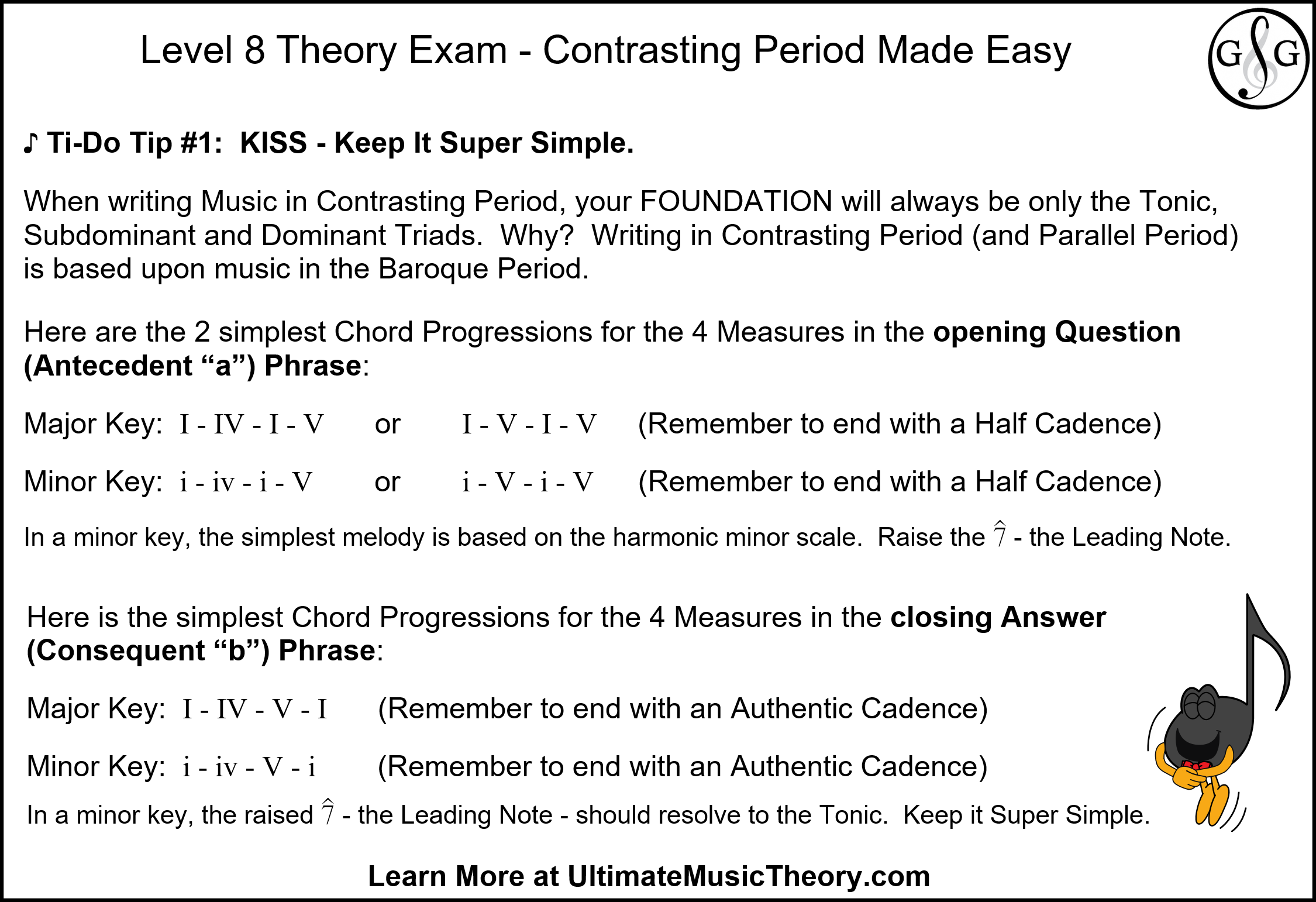
Level 8 Music Theory Exam - Tip #2
Name the key of the given 2 measures. These 2 measures will outline either a Major key or a minor key. Write out your Chord Chart. This was explained on Page 40 of the LEVEL 8 Supplemental Workbook.
Remember that there may not be a raised Leading Note to establish a minor key. If the notes in these 2 measures do not belong to the Major (or minor) Chord Chart, then you are in the wrong key!
The first 4-measure phrase, the "a" phrase or the "Antecedent" Phrase, starts with the given first 2 measures (measures 1 and 2). Students need to write the last 2 measures (measures 3 and 4) to complete this phrase.
The second 4-measure phrase - the "b" phrase or the "Consequent" Phrase, must be written in Contrasting nature.
Contrasting nature simply means that it is written using a different melodic or rhythmic pattern. (But Keep It Super Simple - "different" does not mean "completely opposite without any similarities in style"!)
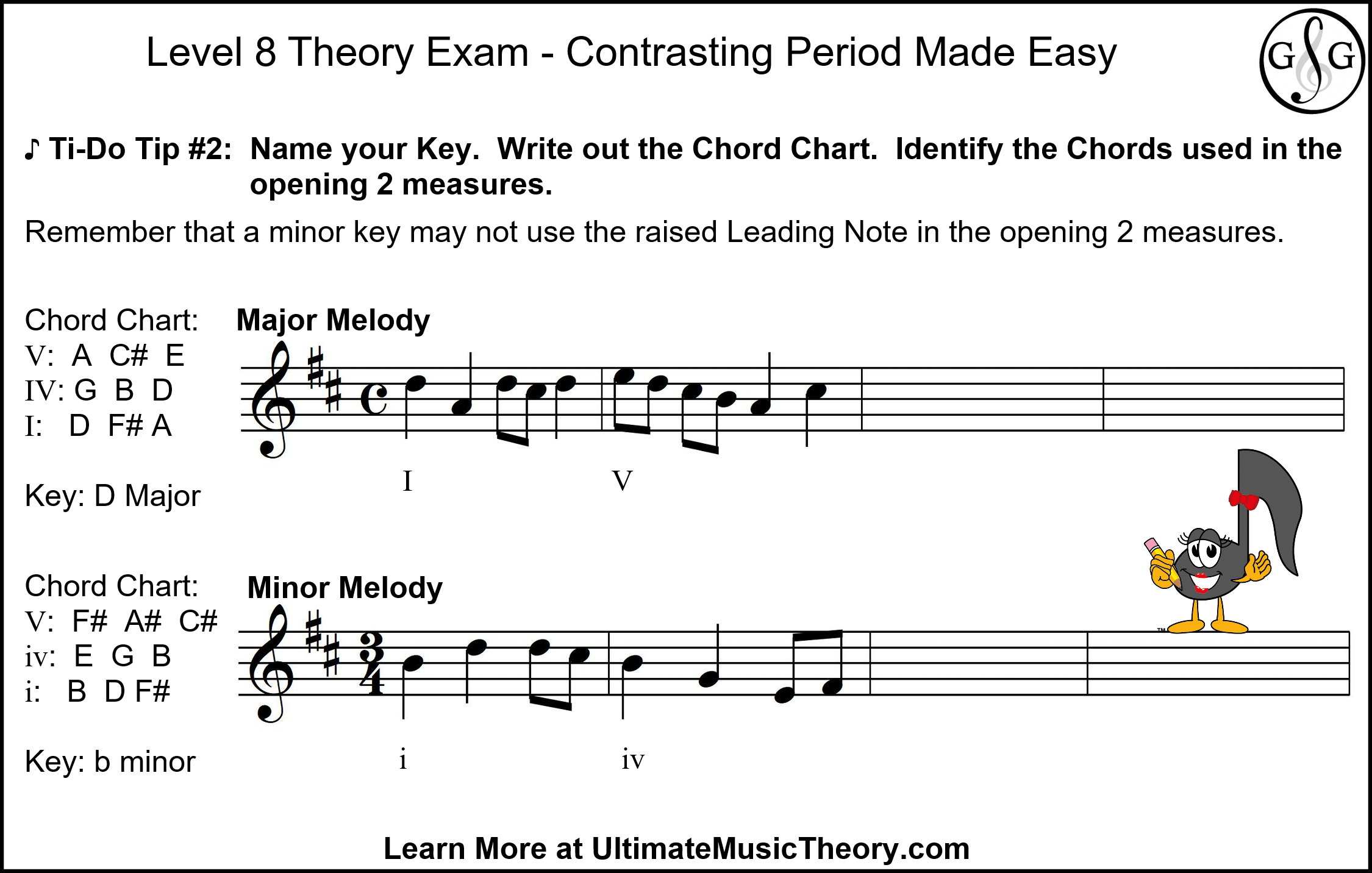
Level 8 Music Theory Exam - Tip #3
Melodies written in Baroque Style (at this level) are based on the Tonic, Subdominant and Dominant Chordal Notes. When you use these notes to map out the chords and cadence notes, you are keeping the melody Super Simple.
Understanding how a melody may move by skip or leap, outlining chords in root position or inversions, is introduced in the LEVEL 5 Supplemental Workbook on Page 58.
Non-Chord Tones are notes that fill in the melodic contour - they fill in the gaps between the Chord Tones. At this level, the Non-Chord Tones should be written on the unaccented beats and not on the accented beats.
Check out the Level 7 Music Theory Exam Blog to review how Non-Chord Tones - Passing Tones and Neighbor Tones - are used to fill in the melody.
The first 4 measure phrase - the "a" phrase or the Antecedant Phrase - must end with a Half Cadence. A Half Cadence is also known as an Imperfect Cadence. Page 40 in the LEVEL 6 Supplemental Workbook is an excellent review of how to write a Half Cadence.
While a Half Cadence can be written from the Subdominant to the Dominant Chords (IV - V or iv - V), the simplest Half Cadence to use is the I - V or the i - V Progression.
Students need to understand the concept of Voice Leading when writing the Half Cadence. Voice Leading refers to how voices move from one chord to another. In Simple Voice Leading, each voice moves as smoothly as possible from one chord note to the other.
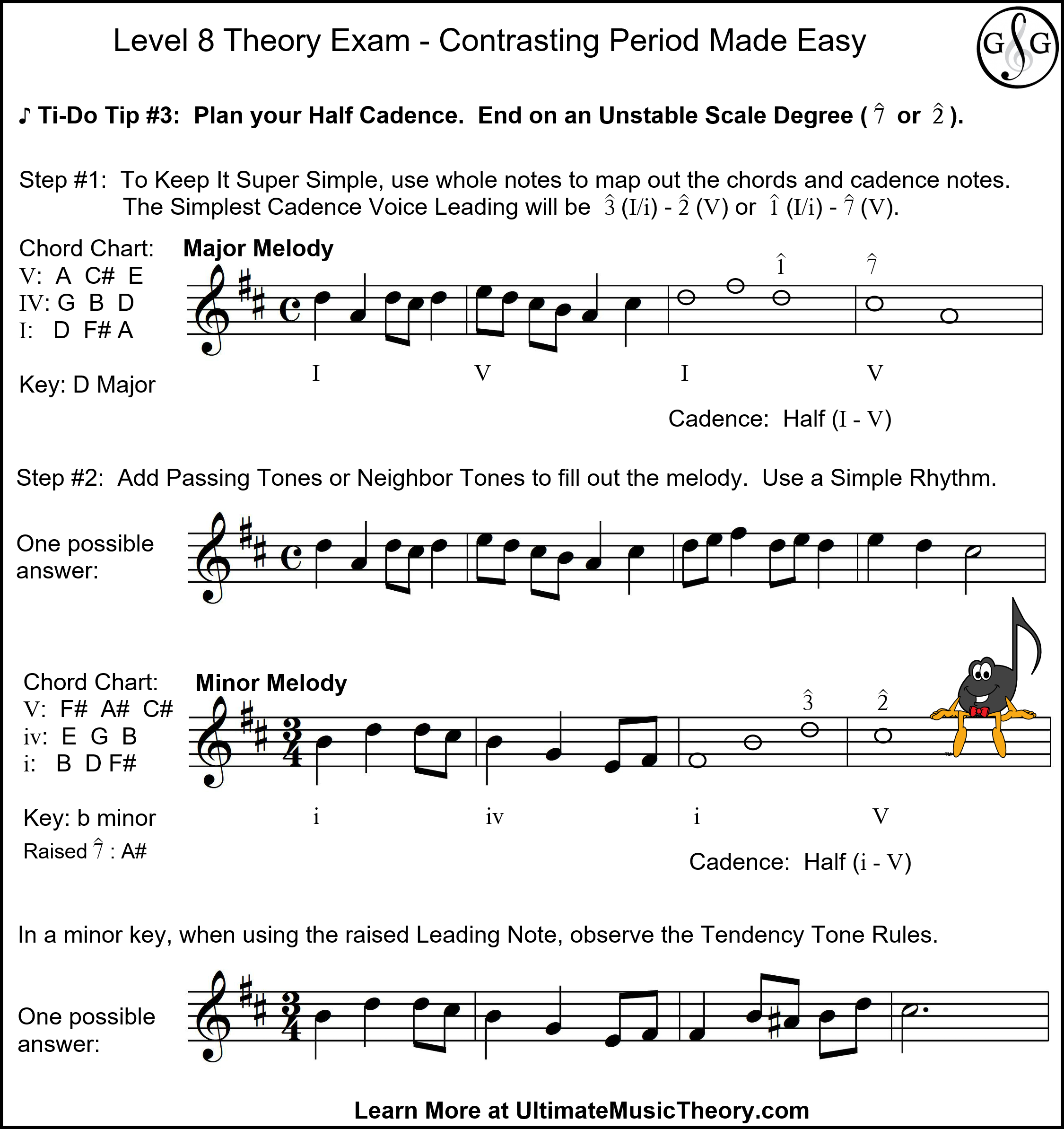
In the LEVEL 7 Supplemental Workbook on Page 44, we learn how to keep a consonant (pleasant or agreeable) sound as the cadence resolves. "Dissonant" intervals create tension and this is not an appropriate sound in Baroque Style Music.
On Page 45, in the LEVEL 7 Supplemental Workbook, we learn about the Tendency Tone Rules. Baroque Style Music sure does love rules! A Tendency Tone is an "active" scale degree that tends to resolve by step to a less active scale degree.
Teachers - remember to check your Student's answers quickly by using the corresponding LEVEL 7 Supplemental Answer Book!
Level 8 Music Theory Exam - Tip #4
On Pages 54 and 55 of the LEVEL 7 Supplemental Workbook, we learn about Contrasting Periods and Consequent Phrases.
There is an excellent chart on how to Keep It Super Simple when writing an Answer Phrase to create a Contrasting Period on Page 55.
I have even highlighted this chart in my own LEVEL 7 Supplement Answer Book and posted a little "flag" on it for super easy reference when analyzing the Compositions that my students have written. It is one of my many "go to" pages when marking!
This Contrasting 4 measure phrase - phrase "b", the Consequent Phrase - must end with an Authentic Cadence (also known as a Perfect Cadence).
The very best final note is, of course, the Tonic note! Establishing your "home key" at the beginning and end of a Baroque Period Melody was very important.
When your Student is finished their melody on the Level 8 Exam, they are not allowed to go find a piano and play it. So teach your Student how to sing and "air play" the melody on the table top.
At this level of musicianship, Students should be able to hear (and feel) a melody. If, when playing it on the table top, they have to use weird finger patterns to "reach" their notes, then the melody is probably too complicated for the Baroque Period.
After completing this, Students must remember to go back and double check:
- Note Values - Is there the correct number of counts in each measure?
- Tonality - If it is minor, is the Leading Tone always raised using an accidental?
- Cadences - Do the Cadences need to be labelled?
- Slurs - Add the slur above each 4 measure phrase.
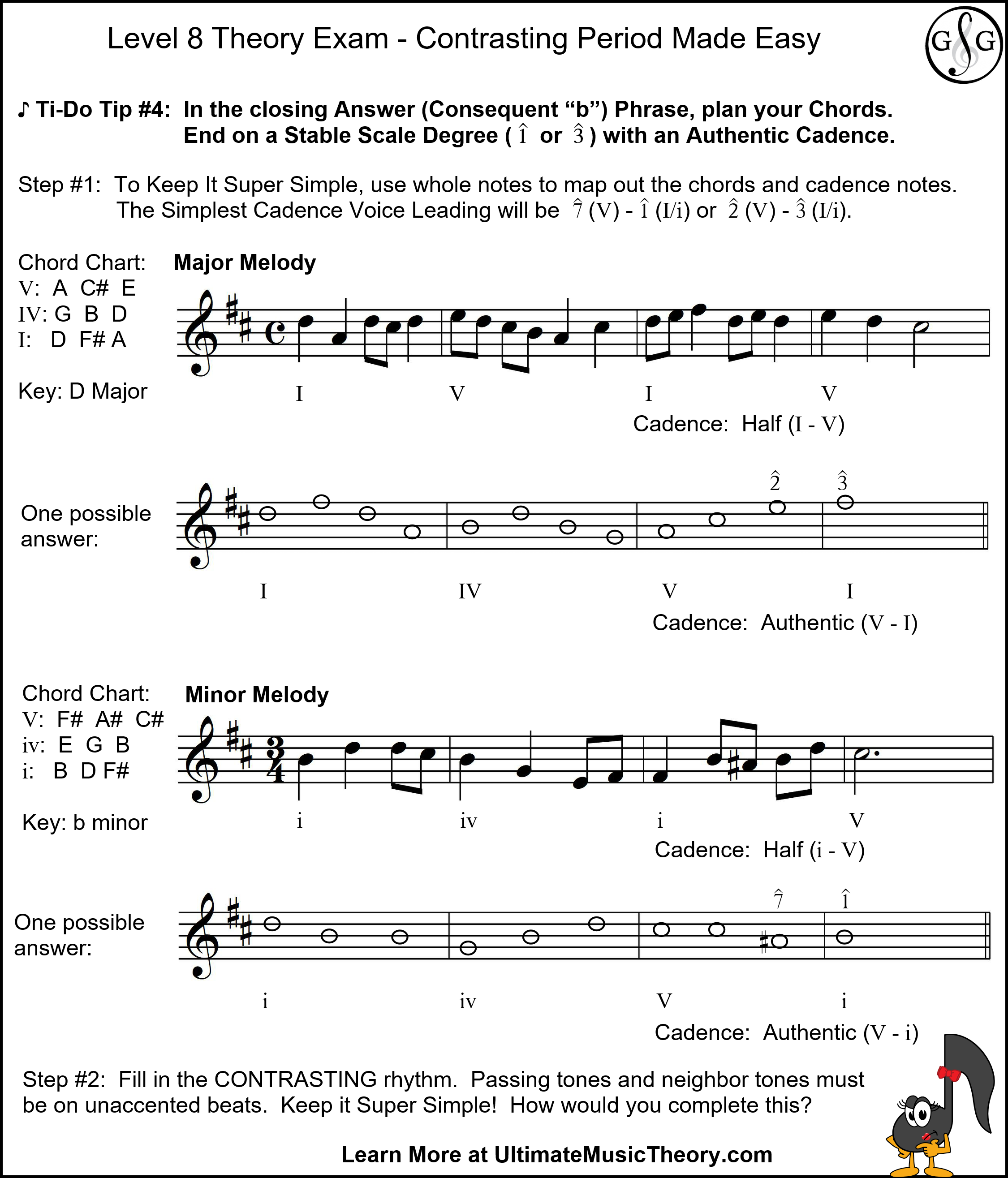
Students do NOT need to erase their Chord Charts or Scale Degree Voice Leading numbers. The Examiner will only mark the Contrasting Period melody itself.
When preparing for this Level 8 Music Theory Exam, I cannot stress enough the importance for students to complete the LEVEL 5, the LEVEL 6 and the LEVEL 7 Supplemental Workbooks. These workbooks provide a step-by-step learning of the language of Melody Writing.
Students "transferring in" to the 2016 RCM Theory Syllabus Requirements will need to complete these Supplemental Workbooks before starting the Ultimate Music Theory Advanced Rudiments Workbook and LEVEL 8 Supplemental Workbook (which are taught together).
At the top of each page in the LEVEL 8 Supplemental Workbook, you will find the corresponding page in the Advanced Rudiments Workbook to make page assignments Super Simple.
If you are a Teacher and are new to the world (and language) of Melody Writing, the Supplemental Teacher Pack will provide you with all the Supplemental Workbooks AND all the matching Answer Workbooks.
I would recommend that Teachers complete these Supplemental Workbooks themselves and check their answers in the Answer Workbooks. While there is no "one correct answer" for melody writing, we have provided Teachers with "one possible answer" to analyze.
To help prepare Students for their RCM Level 8 Music Theory Exam, download the Digital LEVEL 8 Music Theory Practice Exam (providing you with a one-time purchase for multiple printing).
KISS - Keep it Super Simple! Download the corresponding Digital Level 8 Music Theory Practice Exam Answers. You can print it out or store it on your computer.
Ultimate Music Teachers Membership
♪ LEARN ♪ PLAN ♪ TEACH ♪ GROW
The One & ONLY Ultimate Music Teachers Membership
To Become A UMT PRO!
Your Success Path Starts Here - Go To TeachUMT.com Today!
Keep on Learning... With a Smile and a Song!
Shelagh McKibbon-U'Ren


